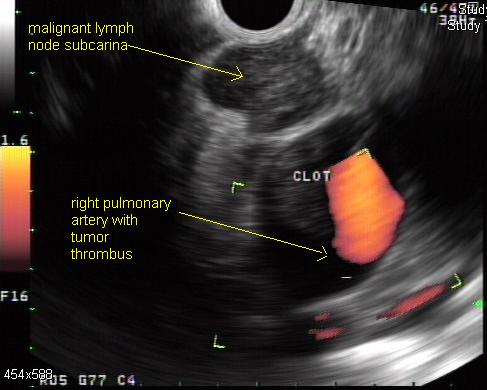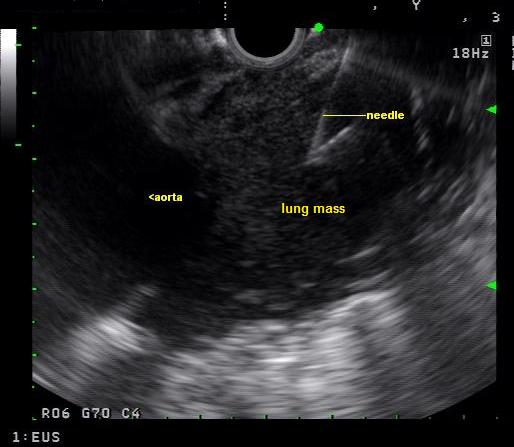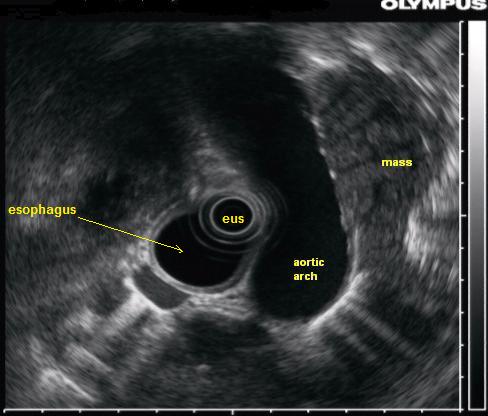Non small cell lung cancer ultrasound: Difference between revisions
No edit summary |
|||
| Line 5: | Line 5: | ||
==Overview== | ==Overview== | ||
On endobronchial and endoscopic ultrasound, characteristic findings of non-small cell lung cancer include enlarged lymph nodes and local invasion to adjacent bronchial structures and mediastinum. Endobronchial ultrasound is a first-line diagnostic modality for mediastinal staging. | On endobronchial and endoscopic ultrasound, characteristic findings of non-small cell lung cancer include enlarged lymph nodes and local invasion to adjacent [[bronchial]] structures and [[mediastinum]]. Endobronchial ultrasound is a first-line diagnostic modality for [[mediastinal]] staging. | ||
==Ultrasound== | ==Ultrasound== | ||
Endobronchial ultrasound is a first-line diagnostic modality for mediastinal staging.The sensitivity of endobronchial ultrasound is 90% and specificity is 97%.<ref name="pmid24484269">{{cite journal |vauthors=Kinsey CM, Arenberg DA |title=Endobronchial ultrasound-guided transbronchial needle aspiration for non-small cell lung cancer staging |journal=Am. J. Respir. Crit. Care Med. |volume=189 |issue=6 |pages=640–9 |year=2014 |pmid=24484269 |doi=10.1164/rccm.201311-2007CI |url=}}</ref><ref name="cancer"> Tests for non-small cell lung cancer. American Cancer Society. http://www.cancer.org/cancer/lungcancer-non-smallcell/detailedguide/non-small-cell-lung-cancer-diagnosis Accessed on February 25, 2016</ref> | Endobronchial ultrasound is a first-line diagnostic modality for mediastinal staging.The sensitivity of endobronchial ultrasound is 90% and specificity is 97%.<ref name="pmid24484269">{{cite journal |vauthors=Kinsey CM, Arenberg DA |title=Endobronchial ultrasound-guided transbronchial needle aspiration for non-small cell lung cancer staging |journal=Am. J. Respir. Crit. Care Med. |volume=189 |issue=6 |pages=640–9 |year=2014 |pmid=24484269 |doi=10.1164/rccm.201311-2007CI |url=}}</ref><ref name="cancer">Tests for non-small cell lung cancer. American Cancer Society. http://www.cancer.org/cancer/lungcancer-non-smallcell/detailedguide/non-small-cell-lung-cancer-diagnosis Accessed on February 25, 2016</ref> | ||
*Indications of endobronchial ultrasound include: | *Indications of endobronchial ultrasound include: | ||
:*Evaluation of lymph nodes and other structures in the mediastinum | :*Evaluation of lymph nodes and other structures in the [[mediastinum]] | ||
:*Mediastinal invasion staging | :*Mediastinal invasion staging | ||
:*Determination of management strategy | :*Determination of management strategy | ||
| Line 18: | Line 18: | ||
*On ultrasound (endobronchial ultrasound), characteristic findings of non-small cell lung cancer include: | *On ultrasound (endobronchial ultrasound), characteristic findings of non-small cell lung cancer include: | ||
:*Enlarged lymph nodes | :*Enlarged lymph nodes | ||
:*Local invasion of adjacent bronchial structures and mediastinum | :*Local invasion of adjacent [[bronchial]] structures and [[mediastinum]] | ||
* The table below summarizes the advantages and disadvantages of both ultrasound modalities, for the diagnostic assessment of non-small cell lung cancer. | * The table below summarizes the advantages and disadvantages of both ultrasound modalities, for the diagnostic assessment of non-small cell lung cancer. | ||
| Line 28: | Line 28: | ||
! style="background: #4479BA; width: 300px;" | {{fontcolor|#FFF|Disadvantages}} | ! style="background: #4479BA; width: 300px;" | {{fontcolor|#FFF|Disadvantages}} | ||
|- | |- | ||
|style="padding: 5px 5px; background: #DCDCDC; font-weight: bold; text-align:center;"| Endobronchial ultrasound (EBUS) | | style="padding: 5px 5px; background: #DCDCDC; font-weight: bold; text-align:center;" | Endobronchial ultrasound (EBUS) | ||
|style="padding: 5px 5px; background: #F5F5F5;"| | | style="padding: 5px 5px; background: #F5F5F5;" | | ||
*Direct visualization of lymph node stations. | *Direct visualization of lymph node stations. | ||
*Complements endoscopic ultrasound: covers lymph node stations 2R and 4R which are difficult to access by endoscopic ultrasound | *Complements endoscopic ultrasound: covers lymph node stations 2R and 4R which are difficult to access by endoscopic ultrasound | ||
*Lower false-negative rate than with blind transbronchial fine needle aspiration and fewer complications | *Lower false-negative rate than with blind transbronchial fine needle aspiration and fewer complications | ||
|style="padding: 5px 5px; background: #F5F5F5;"| | | style="padding: 5px 5px; background: #F5F5F5;" | | ||
*More invasive than endoscopic ultrasound, few practitioners, but rapidly growing in popularity | *More invasive than endoscopic ultrasound, few practitioners, but rapidly growing in popularity | ||
|- | |- | ||
|style="padding: 5px 5px; background: #DCDCDC; font-weight: bold; text-align:center;"| [[Endoscopic ultrasound]] (EUS) | | style="padding: 5px 5px; background: #DCDCDC; font-weight: bold; text-align:center;" | [[Endoscopic ultrasound]] (EUS) | ||
|style="padding: 5px 5px; background: #F5F5F5;"| | | style="padding: 5px 5px; background: #F5F5F5;" | | ||
*Least invasive modality | *Least invasive modality | ||
*Uses the esophagus to access mediastinal lymph nodes | *Uses the esophagus to access mediastinal lymph nodes | ||
*Excellent for staging lymph nodes | *Excellent for staging lymph nodes | ||
*Useful for station 2L and 4L, L adrenal, celiac lymph node | *Useful for station 2L and 4L, L adrenal, celiac lymph node | ||
|style="padding: 5px 5px; background: #F5F5F5;"| | | style="padding: 5px 5px; background: #F5F5F5;" | | ||
*Cannot reliably access right sided paratracheal lymph node stations 2 R and 4R | *Cannot reliably access right sided paratracheal lymph node stations 2 R and 4R | ||
*Accurate discrimination of primary hilar tumors and involved lymph nodes is important | *Accurate discrimination of primary hilar tumors and involved lymph nodes is important | ||
Revision as of 23:10, 23 February 2018
|
Non Small Cell Lung Cancer Microchapters |
|
Differentiating Non Small Cell Lung Cancer from other Diseases |
|---|
|
Diagnosis |
|
Treatment |
|
Case Studies |
|
Non small cell lung cancer ultrasound On the Web |
|
American Roentgen Ray Society Images of Non small cell lung cancer ultrasound |
|
Directions to Hospitals Treating Non small cell carcinoma of the lung |
|
Risk calculators and risk factors for Non small cell lung cancer ultrasound |
Editor-In-Chief: C. Michael Gibson, M.S., M.D. [1]Associate Editor(s)-in-Chief: Maria Fernanda Villarreal, M.D. [2]
Overview
On endobronchial and endoscopic ultrasound, characteristic findings of non-small cell lung cancer include enlarged lymph nodes and local invasion to adjacent bronchial structures and mediastinum. Endobronchial ultrasound is a first-line diagnostic modality for mediastinal staging.
Ultrasound
Endobronchial ultrasound is a first-line diagnostic modality for mediastinal staging.The sensitivity of endobronchial ultrasound is 90% and specificity is 97%.[1][2]
- Indications of endobronchial ultrasound include:
- Evaluation of lymph nodes and other structures in the mediastinum
- Mediastinal invasion staging
- Determination of management strategy
- Real time evaluation of structures
- On ultrasound (endobronchial ultrasound), characteristic findings of non-small cell lung cancer include:
- Enlarged lymph nodes
- Local invasion of adjacent bronchial structures and mediastinum
- The table below summarizes the advantages and disadvantages of both ultrasound modalities, for the diagnostic assessment of non-small cell lung cancer.
Procedure Advantages Disadvantages Endobronchial ultrasound (EBUS) - Direct visualization of lymph node stations.
- Complements endoscopic ultrasound: covers lymph node stations 2R and 4R which are difficult to access by endoscopic ultrasound
- Lower false-negative rate than with blind transbronchial fine needle aspiration and fewer complications
- More invasive than endoscopic ultrasound, few practitioners, but rapidly growing in popularity
Endoscopic ultrasound (EUS) - Least invasive modality
- Uses the esophagus to access mediastinal lymph nodes
- Excellent for staging lymph nodes
- Useful for station 2L and 4L, L adrenal, celiac lymph node
- Cannot reliably access right sided paratracheal lymph node stations 2 R and 4R
- Accurate discrimination of primary hilar tumors and involved lymph nodes is important
Gallery
-
Doppler endoscopic ultrasound: mediastinal lymph node
-
Endoscopic ultrasound: A biopsy window is found and an fine needle aspiration advanced into the mass
-
Endoscopic ultrasound: A lung mass which is partially behind the aorta is seen with endoscopic ultrasound
References
- ↑ Kinsey CM, Arenberg DA (2014). "Endobronchial ultrasound-guided transbronchial needle aspiration for non-small cell lung cancer staging". Am. J. Respir. Crit. Care Med. 189 (6): 640–9. doi:10.1164/rccm.201311-2007CI. PMID 24484269.
- ↑ Tests for non-small cell lung cancer. American Cancer Society. http://www.cancer.org/cancer/lungcancer-non-smallcell/detailedguide/non-small-cell-lung-cancer-diagnosis Accessed on February 25, 2016


